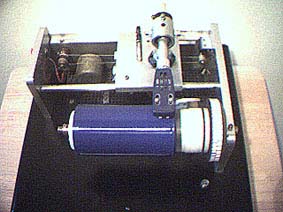
Version: Jan. 7, 2007
 |
|
Version: Jan. 7, 2007 |
by Trevor Hill, 1999
|
Introduction - "Why bother?" As my collection of cylinders grew, it became clear that for others to hear them, it would be necessary to transfer them to another medium, at the time audio tape. With the advent of PC sound cards, large hard disks, CD-ROM burners and advanced audio processing software, the original transfer-to-tape option has easily been exceeded. But whatever the final medium, the process of playing cylinders has been achieved by one of the following:
The machine "A picture is worth a thousand words"...so I'll keep the waffle down, and show you some pictures! |
 |
 |
| Front view of the player - tone-arm in rest position | Top view with tone-arm in playing position with Blue Amberol on mandrel |
|
The first picture shows a front view of my player. Toggle switches control "Power", "Carriage Left/Right" and "Mandrel". A two-color LED indicates tone-arm normal (green) and mis-tracking (red). When a tracking error is sensed by a opto-sensor, the arm is moved incrementally to the left to correct it. The flywheel on the end of the mandrel has two sets of strobe lines, for 120 and 160 rpm. Currently the machine only plays at 160 rpm... I'm still working on this aspect. I'm contemplating a small AC-motor and variable frequency drive. This would eliminate residual brush noise, though could be called "overkill". The tone arm is simplicity itself - I chopped most of the length from an old straight-line tone-arm and make use of the head-shell socket for access to the Stanton 500 Mk2 cartridge. A custom counterweight and tracking opto-sensor (hidden) under the carriage base completes the tracking components. |
 |
 |
| End view showing mandrel bearing and some carriage detail | Rear view showing phono-cartridge out, and dual worm gear drive for the carriage |
|
The opto-sensor under the carriage registers tone-arm mis-tracking in one direction only. Thus the tone arm "falls" from right to left across the cylinder. Flexible cable links the LED/sensor array to the control electronics inside the base. Twin isolated fine-shielded coax links the cartridge output to the output connectors on the back of the unit. No pre-amplification or equalisation is done within the player - this was due to the availability of higher-quality components than I could hope to construct. The tracking motor is fed via a dual worm gear drive to the taut-band that moves the carriage and tone-arm. Even this is sometimes too much and results in skipping... another thing to work on!
Please note that Trevor Wayne Hill sadly passed away on 2nd July 2005.
|

| See the later development of the Hill player: | ||
